Abstract
Background
The main objective of this study was to test Argus II subjects on three real‐world functional vision tasks.
Design
The study was designed to be randomized and prospective. Testing was conducted in a hospital/research laboratory setting at the various participating centres.
Participants
Twenty eight Argus II subjects, all profoundly blind, participated in this study.
Methods
Subjects were tested on the three real‐world functional vision tasks: Sock Sorting, Sidewalk Tracking and Walking Direction Discrimination task
Main Outcome Measures
For the Sock Sorting task, percentage correct was computed based on how accurately subjects sorted the piles on a cloth‐covered table and on a bare table. In the Sidewalk Tracking task, an ‘out of bounds’ count was recorded, signifying how often the subject veered away from the test course. During the Walking Direction Discrimination task, subjects were tested on the number of times they correctly identified the direction of testers walking across their field of view.
Results
The mean percentage correct OFF versus ON for the Sock Sorting task was found to be significantly different for both testing conditions (t‐test, P < 0.01). On the Sidewalk Tracking task, subjects performed significantly better with the system ON than they did with the system OFF (t‐test, P < 0.05). Eighteen (18) of 27 subjects (67%) performed above chance with the system ON, and 6 (22%) did so with system OFF on the Walking Direction Discrimination task.
Conclusions
Argus II subjects performed better on all three tasks with their systems ON than they did with their systems OFF.
Keywords: activities of daily living, clinical trial, outcome measures, retinal prosthesis, visual performance
Introduction
The Argus® II, the first commercially available retinal prosthesis, is intended to partially restore useful vision in blind patients with severe to profound retinitis pigmentosa. Several tests have been developed to test subjects' improvement in vision with the Argus II system in a clinical trial.1, 2 Most of these tests involve computer‐based tasks that are conducted in a highly controlled, laboratory setting. Additionally, we also use self‐reported and observer rated instruments such as the Massof Activity Inventory,3 VisQOL4 and FLORA5 to quantify the improvements in the ability of subjects to perform real world activities of daily living (ADL) while using the Argus II system. However, most of these instruments that are currently in use for low vision testing consist of tasks that are often beyond the scope of what subjects can do with the Argus II system. This research study was thus developed to test subjects on real‐world functional vision tasks that can be scored in an objective manner. These tasks were designed to approximate everyday activities that a totally blind individual may not be able to do, and to measure – in a less‐controlled, more real‐world environment – whether the Argus II system helped the subjects successfully perform them.
These functional vision tasks encompassed several aspects of everyday life: housekeeping chores, social engagement, and orientation and mobility. Each of these aspects was represented by one task developed for this research study: sock sorting, sidewalk tracking, and perceived direction of walking. The sock sorting task was designed to mimic the real‐world scenario of sorting light and dark laundry. It represents a task that is difficult or impossible to do without vision (i.e. through tactile cues alone). The Sidewalk Tracking task was developed to assess subjects' ability to visually track an edge such as the border between a sidewalk and grass in a real‐world outdoor setting, as the visual analogue of the ‘shorelining’ technique commonly employed by white cane users to follow the wall of a building or corridor, a curb, or other tactile guidance.6 The ability to follow along such an edge and detect the transition between two surfaces of different brightness levels may be useful to blind subjects for mobility and orientation purposes in their daily life. The Walking Direction Discrimination (WDD) task was developed to assess subjects' ability to identify the direction of motion of a person passing in front of them. The ability to detect people moving nearby and identify their direction may be useful to blind subjects in unfamiliar environments or in social situations.
Methods
The Argus II system consists of an implant that is surgically placed on and in the eye and external equipment that is worn by the subject. The implant consists of a receiving antenna and an electronics case that are secured to the outside of the eye using a standard scleral band and sutures, and an intraocular electrode array that is secured to the retina over the macula using a retinal tack (Fig. 1a). The electrode array contains 60 electrodes arranged in a 6 × 10 grid. The external equipment consists of the Argus II glasses and the Argus II Video Processing Unit (VPU) (Fig. 1b). A small video camera and transmitting antenna are mounted on the glasses. The VPU is worn by the subject on a shoulder strap or belt, and is used to process the images from the video camera and convert the images into electrical stimulation commands that are wirelessly transmitted to the implant. The electrodes in the array emit stimulation pulses whose amplitude corresponds to the brightness of the scene in that location. Stimulation of the remaining retinal cells results in visual percepts that subjects learn to interpret.
Figure 1.
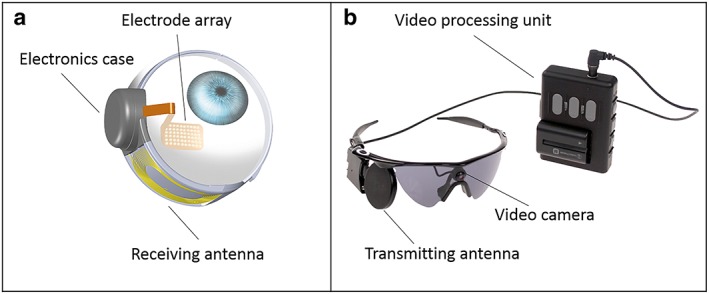
The Argus II System. (a) Implanted components of the system. (b) External components of the system.
The Argus II clinical trial enrolled 30 subjects, 14 from the United States and 16 from Europe, with an average age of 58 years (standard deviation: 10 years) at time of implantation. All subjects had Retinitis Pigmentosa with the exception of one subject who had Choroideremia. Subjects were implanted with the Argus II Retinal Prosthesis System in one eye, typically the worse‐seeing eye. All subjects were profoundly blind and had bare light perception or no light perception at implantation.
Twenty seven subjects performed all three tests between 1 January and 30 November 2010. Subject S2 was not available for testing during this study period, and S13's device was explanted before this study commenced. Subject 25 discontinued participation after the first test, because of intermittent problems with the implant (the external antenna could not consistently establish a radio‐frequency link with the implanted antenna, so we could not guarantee a continuous data and power stream to the electrode array). Subjects performed these tests during or close to a clinical follow‐up visit. The follow‐up time varied for each subject depending on the time of implantation (Argus II subjects were implanted over the course of about two years), between a minimum of 6 months and a maximum of 36 months post‐implant. The tests were conducted during subjects' regular psychophysics testing sessions (all three tasks were not necessarily assessed during the same session). Testing was performed by clinical site staff and/or Second Sight Medical Products staff under direction of the site principal investigator.
The Argus II clinical trial is a multi‐centre trial and is being conducted in accordance with the Declaration of Helsinki and the national regulations for medical device clinical trials in the countries where the study is being conducted. The National Ministries of Health in each of these countries have approved this study. This study has also been approved by the ethics committees or institutional review boards of participating centres. All subjects consented to participate. The clinical trial is posted on www.clinicaltrials.gov, trial registration number NCT00407602.
Task 1: sock sorting
Twenty‐eight (28) subjects were included in this assessment. Subjects were presented with 30 socks jumbled together in a pile: 10 pure white socks, 10 pure black socks and 10 of an intermediate gray colour. To avoid the presence of non‐visual cues, all socks were made of the same material, size and shape; all socks were bought from the same manufacturer and were intended to be indistinguishable by touch. The subjects' task was to sort the socks into three piles representing the three different colours. Some subjects counted piles and ensured that they had 10 socks in each pile; others simply sorted according to what colour they believed each sock to be, resulting in some piles with more or fewer than 10 socks.
The task was performed in the clinic, in lighting conditions that varied from site to site, but that can all be qualified as medium to bright indoor lighting. Subjects sorted the socks four times: once each with the Argus II system ON and OFF and the surface of the table covered in a known‐colour of cloth (either black or white, as preferred by the subject), and once each with the system ON and OFF on a bare table. Only one subject chose to use a white‐coloured cloth; all other subjects used a black‐coloured cloth. Bare tables were as‐found in the clinical site testing rooms; they were various types of desks and tables of various colours of wood or laminate. This condition was intended to produce a more ‘real‐world’ test, as blind Argus II users will not always have control over the level of contrast available in the environment where they use the system. Subjects performed all tests binocularly. All test conditions comprising the task were assessed in the same session with the exception of subject S4, who completed some conditions in a second session less than a month after the first session.
After the subjects had finished sorting the socks and identified which pile was which (i.e. ‘white pile,’ ‘gray pile,’ ‘black pile’), the number of each colour in each pile of socks was counted. Results were thereafter recorded as the number of correctly‐sorted white, gray and black socks. For some analyses, results were further compiled to yield a total percent correct across all colours. T‐tests (assuming unequal variance) were used to test for significant differences between the means for various conditions. Figure 2 shows a subject performing the sock‐sorting test.
Figure 2.
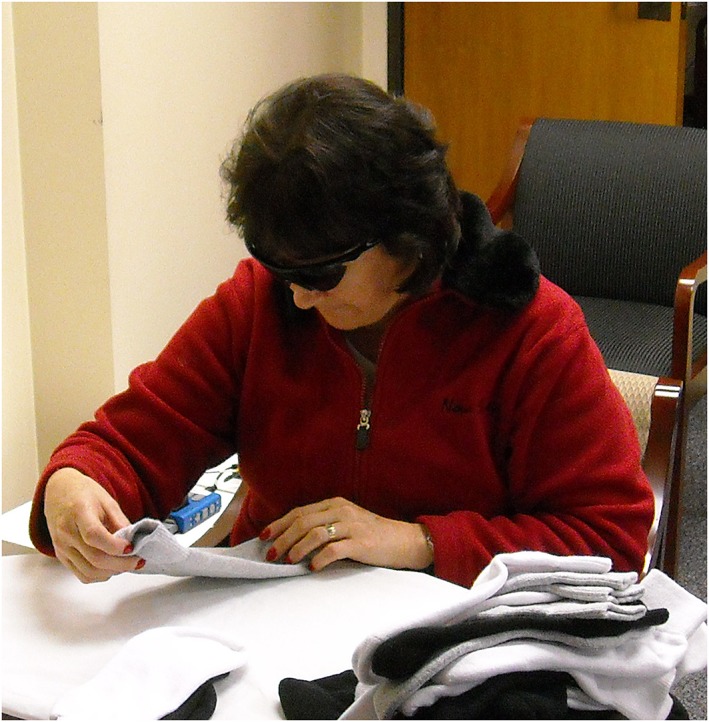
Photograph of an Argus II subject performing the Sock Sorting task.
Task 2: sidewalk tracking
Twenty‐seven (27) subjects were tested on the Sidewalk Tracking task. For this task, the tester identified three different 20‐foot (6‐m) stretches of grass or low shrubbery bordered by concrete or asphalt such as a sidewalk, driveway, parking lot, etc. Some edges were straight; others were curved or angled. The subject was asked to walk along each of the three paths on the pavement within 1 m of the edge without stepping off the pavement, as shown schematically in Figure 3. The subject did not use any mobility aid such as a cane or a guide dog during the test. The test consisted of three trials with the system ON and three trials with the system OFF. The order of trials was varied by the tester. All six trials were completed on the same day with the exception of subject S22, who completed the trials with the System ON a week after the trials with the System OFF, in the same location.
Figure 3.
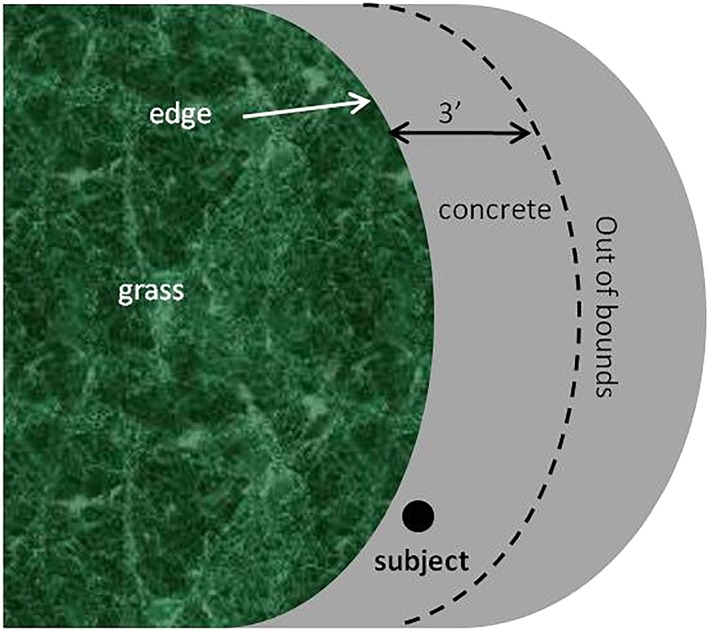
Schematic of the Sidewalk Tracking task.
Performance was measured by the number of times the subject moved out of bounds, that is, when they stepped off the pavement or when they moved farther than 1 m away from the edge. If subjects moved out of bounds during the trial, the tester corrected their position accordingly, and subjects continued to complete the trial. A video of a subject performing this task is included as supplemental material online (Video S1).
Task 3 – Walking Direction Discrimination (WDD)
Twenty‐seven (27) subjects were included in this activity. For this task, the subject was seated, and markers were placed 10 feet away. The test began with two testers positioned on the markers, on either side of the subject, as shown in Figure 4. Every 15 s, prompted by an audible beep, one of the testers crossed the subject's field of view by walking from one side to the other. A few seconds after the audio prompt, the subject identified in what direction the tester was moving.
Figure 4.
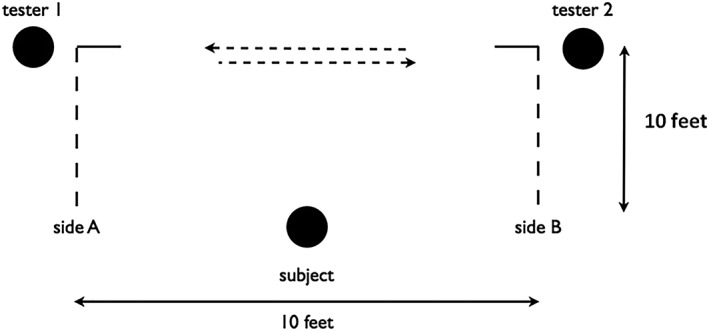
Schematic of the Walking Direction Discrimination task.
This was a two‐alternative forced‐choice test; if the subject did not see movement he/she was required to guess. The test consisted of 40 trials. Some care was taken to reduce the possibility of auditory cues – for example, testers may have removed their shoes if the floor material was hard. As the task was intended to represent real‐world conditions, however, no masking noise or noise‐cancelling headphones were used. The task was performed with the system ON and OFF. Performance was measured by the number of correct answers, that is, the trials in which the subject correctly identified the direction of the person passing in front of him/her.
Results
Task 1: sock sorting
Figure 5 shows the mean percent correct and standard deviation for all four testing conditions (system ON and system OFF, felt‐covered table and bare table). As indicated by the stars in Figure 5, the mean percentages correct OFF versus ON conditions are significantly different for both the felt‐covered table and the bare table (t‐test assuming unequal variances, P < 0.01). We also found that the mean percentage correct was significantly greater for the felt‐covered table versus the bare table with the system ON (t‐test assuming unequal variances, P < 0.01); this suggests that subjects can more reliably identify the colour of the socks against the felt‐covered table.
Figure 5.
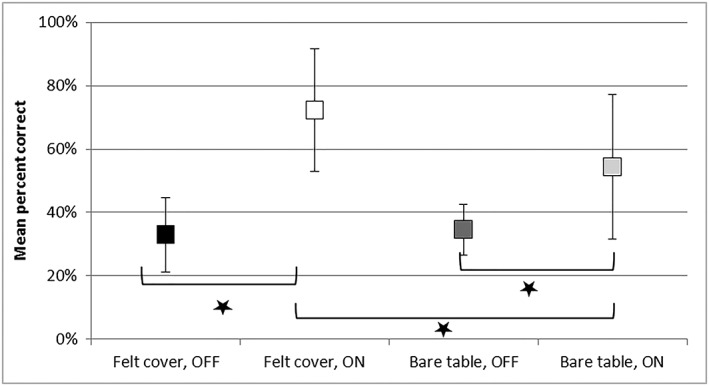
Mean percent correct, sock sorting, all conditions. Stars indicate significant difference, t‐test assuming unequal variances, P < 0.01.
A large majority of subjects perform better on this task with the system ON than with it OFF (27 of 28 with the felt‐covered table, and 21 out of 28 with the bare table). Subject S8 is an exception; this subject performed noticeably better with the system OFF in both conditions. The subject noted during testing that it was possible for him to feel the difference between the white socks and the other colours with no visual information, which likely explains the outlier results.
To investigate whether there was a difference in performance for different colours of socks, the average percent correct was calculated for each colour over all subjects when using the felt‐covered table and bare table (system ON). In other words, for white, the number correct for white socks divided by the total number of white socks was calculated. Means and standard deviations are shown in Figures 6 and 7 for the felt‐covered table and bare table conditions, respectively. There is no significant difference in mean percentage correct between white and gray socks when using the felt‐covered table (t‐test, P > 0.05); however, mean percentages correct for black and gray socks are significantly different (P < 0.01), as are those for white and black socks (P < 0.01), when using the felt‐covered table, as indicated by stars on the figure. This suggests that subjects can more reliably identify black socks than white or gray socks. There is no significant difference in mean percentages correct between white and gray socks, white and black socks, and black and gray socks, when using the bare table. This suggests that subjects have equal difficulty identifying the black, white or gray socks on the bare table.
Figure 6.
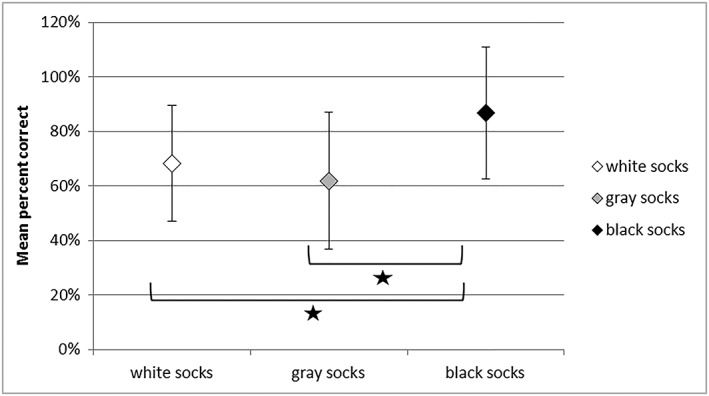
Mean percent correct, sock sorting, by colour (felt‐covered table). Stars indicate significant difference, t‐test assuming unequal variances, P < 0.01.
Figure 7.
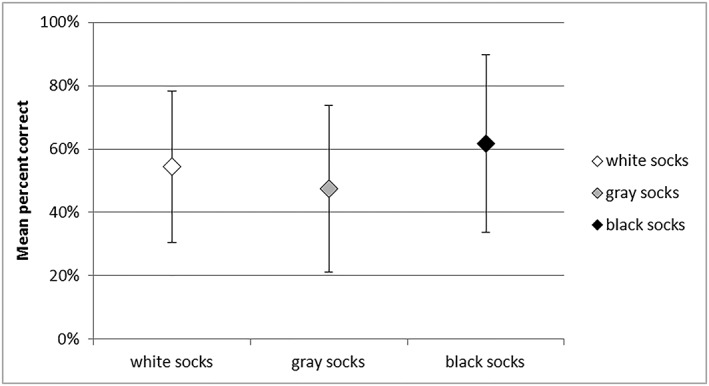
Mean percent correct, sock sorting, by colour (bare table). Stars indicate significant difference, t‐test assuming unequal variances, P < 0.01.
Task 2: sidewalk task
Figure 8 shows a comparison between the system ON and OFF performance for all tested subjects. Eighteen (18) of 27 subjects (67%) performed better (i.e. fewer ‘out of bounds’) with the system ON when compared to system OFF, and seven (27%) performed better with the system OFF (two subjects had equal performance ON and OFF). Mean and standard deviation for ON and OFF are shown in Table 1. A paired t‐test was used to compare the number of out of bounds errors with system ON and system OFF for all subjects. Results indicate that subjects performed significantly better with the system ON than they did with the System OFF (two‐tailed t‐test, P < 0.05).
Figure 8.
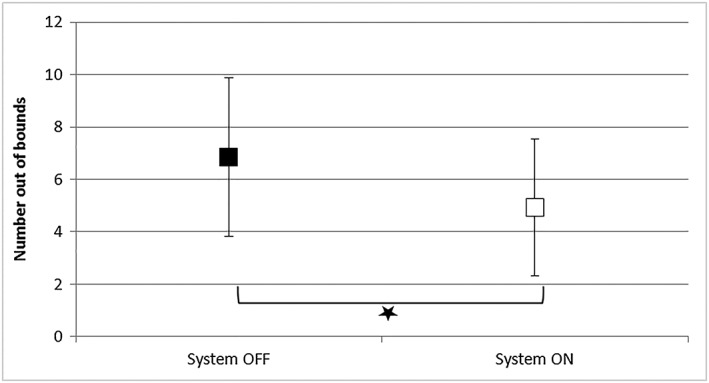
Number of out‐of‐bounds, sidewalk tracking task. Stars indicate significant difference, paired t‐test, P < 0.05.
Table 1.
Sidewalk task summary results
| Out of bound counts – system ON (Mean ± SD) | Out of bound counts – system OFF (Mean ± SD) | P‐value (paired t‐test) |
|---|---|---|
| 4.93 ± 2.62 | 6.85 ± 3.03 | P < 0.05 |
Task 3: Walking Direction Discrimination
Figure 9 shows a comparison between system ON and OFF performance for all tested subjects. According to the binomial distribution (one‐tailed), scoring 26 or more correct answers out of 40 is significantly above chance. Eighteen (18) subjects performed above chance with the system ON, and six subjects performed above chance with the system OFF. (One of these performed significantly above chance only with the system OFF, and the other three performed significantly above chance in both conditions.)
Figure 9.
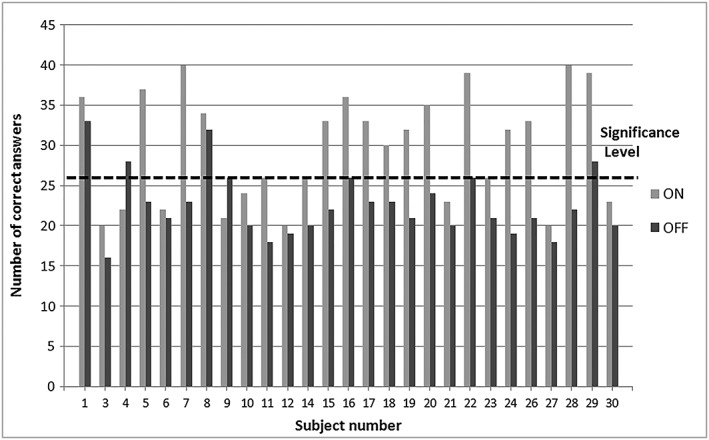
Walking Direction Discrimination results for each subject. Dotted line indicates performance significantly above chance according to the binomial distribution, P < 0.05.
Discussion
Task 1 – sock sorting
The task of sorting laundry by colour was suggested by Argus II subjects as a task they would like to be able to do without help but cannot perform without sight. Based on that suggestion, an objectively scored sock sorting task was developed to be performed in real‐world conditions (i.e. with varying lighting and table surface colour across the different clinical sites). This study demonstrated that Argus II subjects were able to sort white, gray and black socks by colour significantly better with their systems ON than they were with their systems OFF. This held true whether the background colour was controlled (either white or black, according to the subject's preference) or uncontrolled (a bare table). However, performance was better with the felt‐covered table; this is not surprising, as the felt cover held two important advantages: it likely increased the contrast between the socks and the table (compared to intermediate shades of the bare tabletops), and it was a known colour – subjects knew whether the felt was black or white, so perhaps had an easier comparison for the sock colour. Subjects were generally aware of the colour of the bare table, but may not have had a precise mental image of the table colour.
Task 2 – sidewalk task
This task was developed to test blind subjects' ability to detect and track edges in a real‐world outdoor situation where lighting and contrast conditions are uncontrolled, a task that subjects had previously reported as difficult. It is thus encouraging that these results demonstrated that Argus II subjects, as a group, performed significantly better on this uncontrolled task with their system ON versus OFF. Moreover, a quarter of the subjects performed at least 50% better with system ON versus OFF, that is, the number of errors with the system ON was less than 67% of that with the system OFF.
Time to complete this task was not measured, as the test was stopped each time a subject strayed out of bounds. It has been shown, however, that System ON tasks tend to take longer than performing the same task System OFF.7 We would expect the case to be the same here – sidewalk tracking with the System ON is slower, but more accurate.
One may object to the notion that the Sidewalk Tracking task is representative of daily activities: Blind people travelling alone will use either a guide dog or a white cane, and an unaccompanied Argus II wearer should still use a white cane for reasons of safety, both to avoid obstacles and changes in ground level, such as steps, and to signal their blindness to other pedestrians and to motorists. One should realize, however, that certain visible markings, such as paint lines on pavement, may not lend themselves to tactile detection. As an example, an Argus II wearer can use the crosswalk lines to safely cross the street, but the cane she is using will not protect her from veering out of the crosswalk before reaching the other side of the street.
Task 3 – Walking Direction Discrimination
This task was developed to mimic a real‐world situation in which a blind subject, sitting in a stationary position, identifies the walking direction of people passing in front of him or her (as might be useful while sitting on an outdoor bench or in a social situation). Argus II subjects, as a group, have significantly better performance on this task with their systems ON than OFF (two‐tailed t‐test, P < 0.05). Although 15 subjects were able to perform significantly above chance with their systems ON, only four were able to reach this performance with the system OFF. Those four were likely using auditory cues to perform the task without the system. Although this task could be controlled to eliminate auditory cues, it is believed to be more valuable to present a real‐world environment (while still controlling enough factors to allow for objective measurement of performance). In this way, the results shown here represent actual benefit of the system and other sensory information, compared with use of only residual vision and other sensory information.
The tasks are representative of ADL tasks and were developed as a complementary assessment for Argus II subjects; they mimicked activities that subjects perform in their daily lives, but were objectively scored. They provided information about how subjects can use their systems for complex tasks in different uncontrolled environments.
The results indicated that performance on these tasks varied across subjects, but that as a group, Argus II subjects performed better on all three tasks (Sock Sorting, Sidewalk Tracing and WDD) with their systems ON than they did with their systems OFF.
Interestingly, high performance on these tasks did not always correspond to high performance on other tasks such as character recognition8 or grating visual acuity (data not shown). However, more importantly, some subjects performed very well on these functional vision tasks but not as well on other assessments. This suggests that when assessing the benefit that subjects have received from use of the Argus II system, certain daily activities may show benefits that cannot easily be demonstrated in standardized laboratory tests.
Supporting information
Video S1. Sidewalk tracking task.
Supporting info item
Supporting info item
Supporting info item
Dagnelie, G. , Christopher, P. , Arditi, A. , da Cruz, L. , Duncan, J. L. , Ho, A. C. , Olmos de Koo, L. C. , Sahel, J.‐A. , Stanga, P. E. , Thumann, G. , Wang, Y. , Arsiero, M. , Dorn, J. D. , Greenberg, R. J. , and the Argus® II Study Group (2017) Performance of real‐world functional vision tasks by blind subjects improves after implantation with the Argus® II retinal prosthesis system. Clinical & Experimental Ophthalmology, 45: 152–159. doi: 10.1111/ceo.12812.
Competing/conflicts of interest: All authors, through their participating institutions, were supported by research funds from Second Sight Medical Products Inc (SSMP). Punita Christopher, Maura Arsiero, Robert J. Greenberg, and Jessy Dorn are employees of and have stock options in SSMP. Robert J. Greenberg has an equity interest in SSMP and intellectual property rights to the Argus® II retinal prosthesis system and related technology.
Funding sources: Funded by National Institutes of Health grant no. 5R01EY012893 (R.J.G., principal investigator) through the National Eye Institute, and by Research/?Development of Artificial Retinas for the Blind and National Institutes of Health grant no. 1RC3EY020778‐01 (R.J.G., principal investigator). The clinical trial was sponsored by Second Sight Medical Products, Inc.
References
- 1. Humayun MS, Dorn JD, da Cruz L, et al. Interim results from the international trial of Second Sight's visual prosthesis. Ophthalmology 2012; 119: 1547–1554. [DOI] [PMC free article] [PubMed] [Google Scholar]
- 2. Ho AC, Humayun MS, Dorn JD, et al. Long‐term results from an epiretinal prosthesis to restore sight to the blind. Ophthalmology 2015; 122: 1547–1554. [DOI] [PMC free article] [PubMed] [Google Scholar]
- 3. Massof RW, Ahmadian L, Grover LL, et al. The Activity Inventory: an adaptive visual function questionnaire. Optom Vis Sci 2007; 84: 763–774. [DOI] [PMC free article] [PubMed] [Google Scholar]
- 4. Peacock S, Misajon R, Iezzi A, Richardson J, Hawthorne G, Keeffe J. Vision and quality of life: development of methods for the VisQoL vision‐related utility instrument. Ophthalmic Epidemiol 2008; 15: 218–223. [DOI] [PMC free article] [PubMed] [Google Scholar]
- 5. Geruschat DR, Flax M, Tanna N, et al. FLORA: Phase I development of a functional vision assessment for prosthetic vision users. Clin Exp Optom 2015; 98: 342–347. [DOI] [PMC free article] [PubMed] [Google Scholar]
- 6. Wiener WR, Welsh RL, Blasch BB. Foundations of Orientation and Mobility, Third Edition: Volume 2, Instructional Strategies and Practical Applications. New York, NY: AFB Press, American Foundation for the Blind, 2010. [Google Scholar]
- 7. Barry MP, Dagnelie G. Use of the Argus II retinal prosthesis to improve visual guidance of fine hand movements. Invest Ophthalmol Vis Sci 2012; 53: 5095–5101. [DOI] [PMC free article] [PubMed] [Google Scholar]
- 8. da Cruz L, Coley BF, Dorn J, et al. The Argus II epiretinal prosthesis system allows letter and word reading and long‐term function in patients with profound vision loss. Br J Ophthalmol 2013; 97: 632–636. [DOI] [PMC free article] [PubMed] [Google Scholar]
Associated Data
This section collects any data citations, data availability statements, or supplementary materials included in this article.
Supplementary Materials
Video S1. Sidewalk tracking task.
Supporting info item
Supporting info item
Supporting info item


